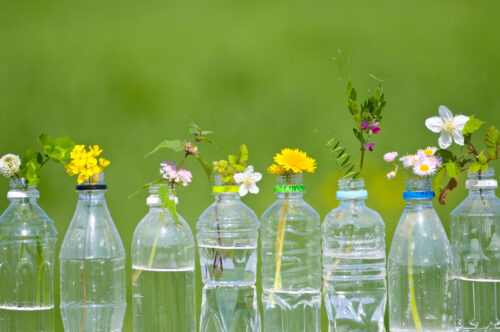AdvanTech Plastics is at the forefront of the move toward bio-assimilation, the last and final stage of biodegradation, when plastic polymers are consumed by microorganisms and simply cease to exist. Bio-assimilation is vital in a world full of plastic waste that is not being recycled because of cost and is sometimes simply incinerated, warming the planet, or dumped in landfills or the sea.
How does bio-assimilation work? Micro-organisms, such as Ideonella sakaiensis (first identified in 2016) grow as a colony on polyolefin surfaces by adhering to it with thin appendages. These appendages secrete plastic-degrading enzymes which enables the micro-organisms to consume polyolefins such as polypropylene (PP) and polyethylene (PE). This is the final stage of plastic biodegradation, leaving behind no microplastics, in either land or water environments.
The Problem with Conventional Plastics
Traditional plastics, primarily derived from petroleum-based sources, have become ubiquitous in our daily lives. However, their durability and resistance to degradation pose a significant environmental challenge. It can take hundreds of years for some plastics to break down in the environment, leading to issues like plastic accumulation in landfills, water bodies, and even the ocean. This has adverse effects on wildlife, ecosystems, and human health.
The Role of Bio-Assimilation
Bio-assimilation aims to mitigate these environmental problems by incorporating biodegradable materials into the plastic injection molding process. This approach allows for the production of plastics that retain their structural integrity during their useful life but gradually break down into harmless substances when exposed to environmental conditions.
Biodegradable Materials in Injection Molding
To achieve bio-assimilation, manufacturers use biodegradable materials such as polylactic acid (PLA), polyhydroxyalkanoates (PHA), and starch-based plastics in combination with traditional polymers like polyethylene (PE) and polypropylene (PP). These biodegradable additives enhance the overall degradability of the plastic product without compromising its strength or functionality.
Benefits of Bio-Assimilation in Injection Molding
- Environmental Sustainability: Bio-assimilation reduces the environmental impact of plastic products by facilitating their natural decomposition. This helps in reducing the accumulation of non-biodegradable plastics in the environment.
- Resource Conservation: The use of biodegradable materials decreases the dependency on fossil fuels, contributing to the conservation of finite resources.
- Reduced Pollution: Bio-assimilation minimizes the release of harmful pollutants associated with traditional plastics, promoting cleaner and safer production processes.
- Consumer Demand: With an increasing awareness of environmental issues, consumers are more likely to favor products made with bio-assimilation, thus enhancing market competitiveness for manufacturers.
- Regulatory Compliance: Many countries and regions have implemented regulations and standards aimed at reducing plastic waste. Bio-assimilation can help manufacturers comply with these requirements.
Challenges and Considerations
While bio-assimilation offers numerous advantages, it is not without its challenges:
- Cost: Biodegradable materials tend to be more expensive than traditional plastics, which can increase production costs.
- Material Compatibility: Achieving the right balance of biodegradability and structural integrity can be challenging, requiring careful formulation and testing.
- Processing Parameters: The injection molding process may need adjustments to accommodate biodegradable materials properly.
- Market Education: Raising awareness among consumers and industry stakeholders about bio-assimilation and its benefits is essential for its widespread adoption.
Applications of Bio-Assimilation in Injection Molding
Bio-assimilation can be applied to a wide range of injection-molded products, including packaging materials, disposable cutlery, automotive components, and consumer goods. Its versatility makes it a valuable tool in reducing plastic pollution across various industries.
Bio-assimilation in the plastic injection molding industry represents a significant step toward addressing the environmental challenges posed by traditional plastics. By combining the strength and functionality of conventional plastics with the biodegradability of natural materials, manufacturers can produce sustainable products that benefit both the environment and consumers. While there are challenges to overcome, the long-term benefits of bio-assimilation make it a promising avenue for a greener and more responsible plastic industry. As consumer awareness and regulatory pressures continue to grow, the adoption of bio-assimilation is poised to play a crucial role in shaping the future of plastic production.
